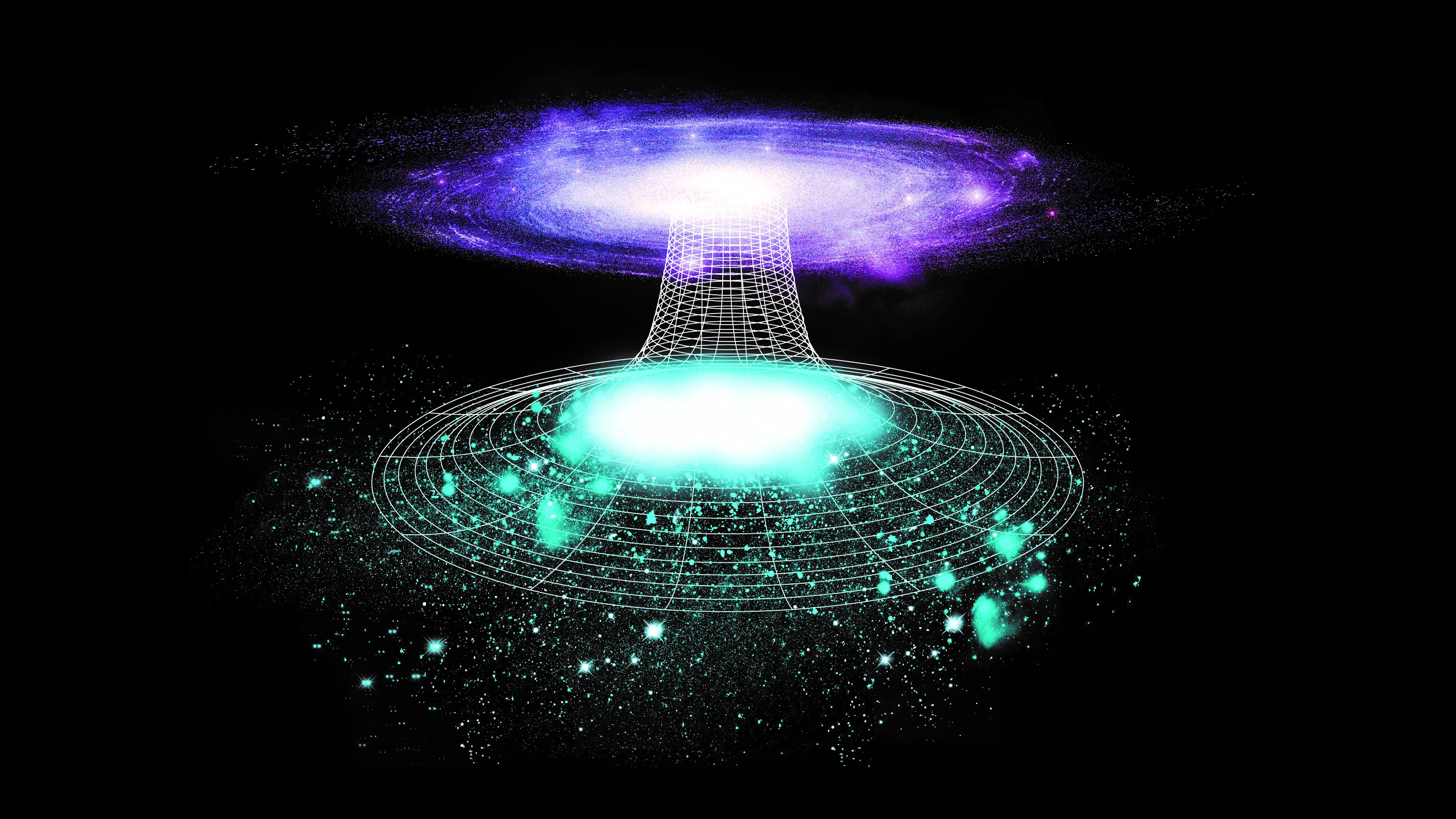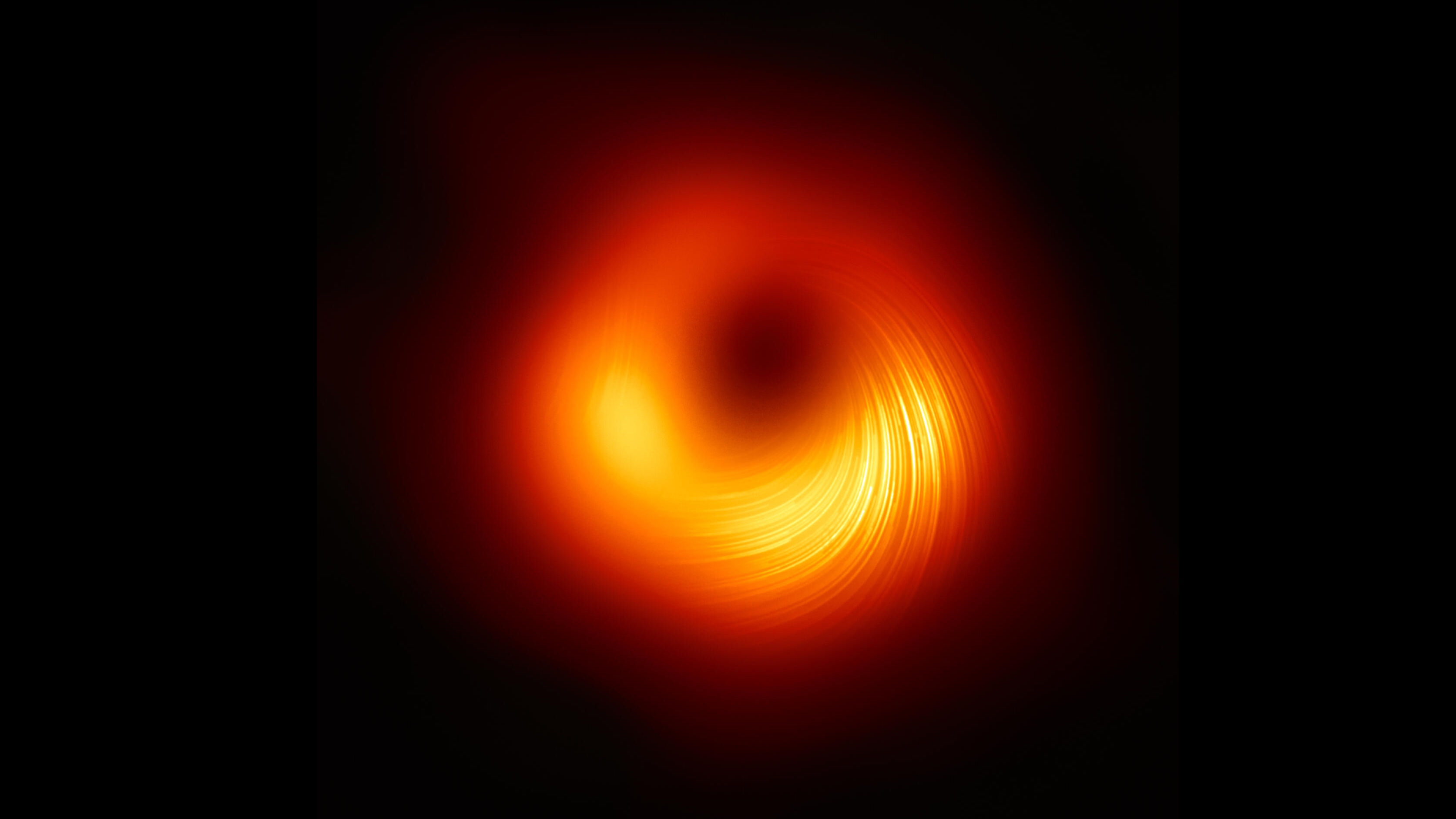White holes: What we know about black holes' neglected twins

White holes are theoretical cosmic regions that function in the opposite way to black holes. Just as nothing can escape a black hole, nothing can enter a white hole.
White holes were long thought to be a figment of general relativity born from the same equations as their collapsed star brethren, black holes. More recently, however, some theorists have been asking whether these twin vortices of spacetime may be two sides of the same coin.
To a spaceship crew watching from afar, a white hole looks exactly like a black hole. It has mass. It might spin. A ring of dust and gas could gather around the event horizon — the bubble boundary separating the object from the rest of the universe. But if they kept watching, the crew might witness an event impossible for a black hole — a belch. "It's only in the moment when things come out that you can say, 'ah, this is a white hole,'" said Carlo Rovelli, a theoretical physicist at the Centre de Physique Théorique in France.
Physicists describe a white hole as a black hole's "time reversal," a video of a black hole played backwards, much as a bouncing ball is the time-reversal of a falling ball. While a black hole's event horizon is a sphere of no return, a white hole's event horizon is a boundary of no admission — space-time's most exclusive club. No spacecraft will ever reach the region's edge.
Objects inside a white hole can leave and interact with the outside world, but since nothing can get in, the interior is cut off from the universe's past: No outside event will ever affect the inside. "Somehow it's more disturbing to have a singularity in the past that can affect everything in the outside world," said James Bardeen, a black-hole pioneer and professor emeritus at the University of Washington.
The theoretical twin
Einstein's field equations hit physics like a tsunami in 1915, and theorists are still sorting through the wreckage. Beyond describing the force of gravity, his hypotheses also brought a paradigm-shattering message about the nature of reality. More than a rigid backdrop, space and time bend and fold along with the mass of stars and planets. That insight sparked a race to calculate just how much abuse space could take from the matter that drifts through it.
Within a year, physicist and astronomer Karl Schwarzschild found the first exact solution to Einstein's equations, calculating how space-time curves around a single ball of mass. In his answer lay the seeds of what physicists today call a singularity — a spherical mass shrunken down to an infinitely dense point, wrapping space around it so tightly that the region pinches off from the rest of the universe. It forms a no man's land whose event horizon fractures the link between cause and effect.
Breaking space news, the latest updates on rocket launches, skywatching events and more!
Black holes, the most famous singularities, are regions of space so warped that no exits exist. The outside universe can influence the inside of a black hole's horizon, but the interior can't affect the exterior.
When mathematician Martin David Kruskal extended Schwarzchild's black hole description in 1960 to cover all domains of space and time, his new picture contained a reflection of the black hole singularity, although he didn't realized its significance at the time. Later, as black holes entered the vernacular, a natural term emerged for their theoretical twins.
"It took 40 years to understand black holes, and it's only recently that people have been focusing on white holes," Rovelli said.
Related: Einstein's Theory of Special Relativity
White hole FAQs answered by an expert
We asked Geraint Lewis, an astrophysicist at the University of Sydney some questions about white holes.

Geraint Lewis is a Professor at the University of Sydney, who specializes in the use of the phenomenon of gravitational lensing as predicted by general relativity to probe the structure of the universe.
What are white holes?
White holes emerge from the solutions of Einstein's theory of general relativity devised by Karl Schwarzschild in 1916, just a year after the theory was first published.
Schwarzschild was the guy who wrote down the mathematics that describes black holes in the universe as completely collapsed objects. He had to make a choice, there is nothing in general relativity that dictates which direction time flows in.
You could point the clock in this particular direction, and that's what gives you this picture where things fall into a black hole. That's where gravity is attractive, but you could also choose the opposite direction in which time flows and get the opposite effect. So as well as a black hole, the mathematics of Schwarzschild also gives us a white hole by just flipping the way that time works.
How do white holes differ from black holes?
The white hole is, in a hand-wavy sense, the inverse of a black hole. So in a black hole, you have an intense gravitational field that pulls things in you've got this one-way membrane called the event horizon. You cross that event horizon, and then you are captured, you cannot escape from that black hole. Gravity has got you, and your future is destined to be at the center of the black hole, no matter what you do.
Now a white hole is the flip of that. So a white hole is almost like anti-gravity endlessly ejecting material. With a white hole, you have an event horizon, where stuff from the inside crosses the event horizon and gets ejected into the universe, and you can't actually get into the white hole.
So in the black hole, you can pass inwards, but not outwards in a white hole, you can pass outwards but not inwards.
Is there any evidence that white holes exist?
The answer is no, really. I mean, there are speculations about some weird things in the universe that might have white home signatures. There's nothing that we can point out in the same way we can point out a black hole that says, 'yes, this is a white hole.'
Maybe that's because of the choice that we make with regard to the past and future, maybe there is only one real choice on the direction of the future, which means we can only have black holes solutions. Some scientists suggest that the fact that the universe is asymmetric, we see a start with the Big Bang, and we have an infinite future ahead of us, which means that the future gets written into the universe, it sets a one-way time direction which means that only the black hole solution can exist. And so even though mathematically possible to have a white hole, the fact that our universe is asymmetric means that they're not physically realized.
What could astronomers look for to discover a white hole?
People think that this would be a place where things would be ejected with lots of energy. Scientists like Roger Penrose theorize that a white hole is like an exit for a black hole in another universe. So material would fall into a black hole in one universe and would get ejected into another universe via a white hole.
So people have looked for places where energy seems to be flowing into the universe, but something that has the distinctive signature of a white hole, there's nothing definitive out there.
Do you believe white holes exist?
My bet would be that in our universe, we don't have white holes.
I love some of the more exotic sorts of things that you can do in relativity. So I still have my fingers crossed for time warps and warp drives and things that may be theoretically possible but might not be realizable. So I've got a teeny percentage that hopes that white holes can exist, but in my heart of hearts, I think that maybe they don't.
Why white holes may not exist
While general relativity describes white holes in theory, no one knows how one might actually form. A black hole cordons off its bit of space when a star collapses into a tiny volume, but playing this video backwards doesn't make physical sense. An event horizon exploding into a functional star would look a bit like an egg unscrambling itself — a violation of the statistical law demanding that the universe gets messier over time.
Even if large white holes did form, they probably wouldn't hang around too long. Any outgoing matter would collide with the matter in orbit, and the system would collapse into a black hole. "A long-lived white hole, I think, is very unlikely," said Hal Haggard, a theoretical physicist at Bard College in New York.
Why white holes might exist
For a while, white holes seemed to share the fate of wormholes — mathematically permissible contortions of space-time likely prohibited by reality. But in recent years, some physicists have brought white holes back in an attempt to save their darker siblings from an unseemly death.
Ever since Stephen Hawking realized in the 1970s that black holes leak energy, physicists have debated how the entities could possibly shrivel up and die. If a black hole evaporates away, many ask, what happens to the internal record of everything it swallowed? General relativity won't let the information out and quantum mechanics forbids its deletion.
"How does a black hole die? We don't know. How is a white hole born? Maybe a white hole is the death of a black hole," Rovelli said. "The two questions join nicely, but you have to violate the general relativity equations in the passage from one to the other."
Rovelli is a founder of quantum loop gravity, an incomplete attempt to move beyond general relativity by describing space itself as built from Lego-style particles. Guided by tools from this framework, he and others describe a scenario where a black hole grows so small that it no longer obeys the common-sense rules of stars and billiard balls. On the particle level, quantum randomness takes over and the black hole could transform into a white hole.
Such a microgram-size white hole, being similar in mass to a human hair, would have none of the gravitational drama of its black hole ancestor, according to Haggard, but would hide a cavernous interior containing the information of everything it had swallowed in its previous life. Too small to attract orbiting matter, the white hole might remain stable enough to eventually spit out all the information accumulated by its forerunner.
In this picture, white holes would one day come to dominate the universe, after the stars have burnt out and black holes have withered. Any observers then could easily detect the objects as relatively large particles Haggard speculates, but those days are countless trillions of times the current age of the universe in the future. "It's the craziest time scale I've seen in physics," Haggard said.
The ultimate white hole
Alternatively, the aftermath of a white hole may exist everywhere. To black hole physicists, the Big Bang's explosion of matter and energy looks like potential white hole behavior. "The geometry is very similar in the two cases," Haggard said. "Even to the point of being mathematically identical at times."
Cosmologists call this picture the "the Big Bounce," and some seek characteristic white hole features in the universe's earliest observable light. Rovelli also wonders if violent radio bursts represent the cries of theoretical mini black holes left over from the Big Bang as they make an early transition into white holes (although this explanation appears increasingly unlikely).
The universe may not contort itself into all the shapes general relativity allows, but Haggard thinks physicists should follow this rabbit hole all the way to the end. "Why wouldn't you investigate whether they [white holes] have interesting consequences," he said. "It may be that those consequences aren't what you expected, but it would be foolhardy to ignore them."
Additional resources
Discover more interesting facts about white holes with this article by Fraser Cain on Universe Today. See how white holes emerge from the same space-time diagrams as black holes in PBS's space-time video. Explore the parallels between a white hole and the Big Bang in this article from Nautilus.
Bibliography
- Bardeen, James M. "Models for the nonsingular transition of an evaporating black hole into a white hole." arXiv preprint arXiv:1811.06683 (2018).
- Bianchi, Eugenio, et al. "White holes as remnants: a surprising scenario for the end of a black hole." Classical and Quantum Gravity 35.22 (2018): 225003.
- Cowen, Ron. "Quantum bounce could make black holes explode." Nature News doi 10 (2014).
- Kedem, Yaron, Emil J. Bergholtz, and Frank Wilczek. "Black and white holes at material junctions." Physical Review Research 2.4 (2020): 043285.
- Nikitin, Igor. "Stability of white holes revisited." arXiv preprint arXiv:1811.03368 (2018).
- Bardeen, James M. "Black holes to white holes I. A complete quasi-classical model." arXiv preprint arXiv:2006.16804 (2020).

Charlie Wood is a freelance journalist covering physical sciences both on and off this pale blue dot. He contributes to Space.com and LiveScience, as well as Popular Science, Scientific American, Quanta Magazine, and others. These days he writes from New York but in previous lives he taught physics in Mozambique and science English in Japan. Find him on Twitter @walkingthedot.
- Daisy DobrijevicReference Editor

